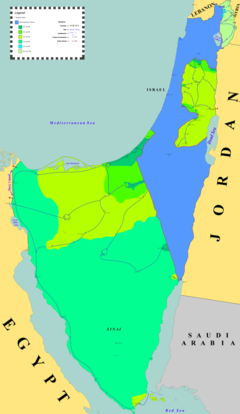| Part of the Arab–Israeli conflict, the Suez Crisis, and the Six-Day War | |
 Territories occupied by Israel during the Six-Day War, 1967 | |
| Date | 29 October 1956 – 7 March 1957 (first occupation) 5 June 1967 – 25 April 1982 (second occupation) |
|---|---|
| Location | Sinai Peninsula, Egypt |
| Motive | Thwarting the Egyptian-led blockade of Israel (1949–1967) |
| Outcome | Egypt–Israel peace treaty |
| Verdict |
|
The Sinai Peninsula, which is a part of Egypt, has been militarily occupied by Israel twice since the beginning of the Arab–Israeli conflict: the first occupation lasted from October 1956 to March 1957, and the second occupation lasted from June 1967 to April 1982.
Israel initially seized the Sinai Peninsula during the Suez Crisis, when it attacked Egypt in response to the Egyptian blockade against all Israeli shipping; the Egyptians had been contesting Israel's freedom of navigation through the Straits of Tiran and the Suez Canal since 1949, impacting the country's ability to import and export goods during the Israeli austerity period. Although the occupation allowed Israel to re-open the Straits of Tiran, the Suez Canal was closed until 1957, when Israeli troops withdrew from Egypt.
In the mid-1960s, amidst warnings from Israeli officials that another blockade would be a casus belli, Egypt re-imposed the blockade against Israel and subsequently lost the Sinai Peninsula in the 1967 Arab–Israeli War. Like before, Israel's occupation allowed it to re-open the Straits of Tiran, but, once again, the Suez Canal was closed until 1975. For the next three years, Egypt, seeking to regain the territory it had lost, launched the unsuccessful War of Attrition against Israel. Later, a large-scale Egyptian military offensive against Israel, known as Operation Badr, triggered the 1973 Arab–Israeli War, which ended with the Egypt holding most of the east bank of the Suez. By 1979, the United States had successfully negotiated the Egypt–Israel peace treaty: the Egyptians recognized Israel as a sovereign state, recognized the Straits of Tiran and the Gulf of Aqaba as international waterways, and agreed to demilitarize along Israel's border. In exchange, Israel agreed to withdraw all civilians and soldiers from the Sinai Peninsula and return it to Egypt. On 25 April 1982, Israel's withdrawal concluded and Egypt has since left the Sinai Peninsula demilitarized, marking the first instance of peace between Israel and an Arab country.[1]
Between 1967 and 1982, a total of 18 Israeli settlements were constructed throughout the Sinai Peninsula, primarily along the Gulf of Aqaba and in the areas to the south of the formerly Egyptian-occupied Gaza Strip. Additionally, Israel dismantled two bases of the Israeli Air Force, one base of the Israeli Navy, and a number of other government/military installations, including most Israeli-controlled oil resources.
- ^ "Upon completion of the interim withdrawal provided for in Annex I, the parties will establish normal and friendly relations, in accordance with Article III (3)." Frank Thompson (1978). Jimmy Carter. US Government Printing Office. p. 496. ISBN 0-16-058935-5.